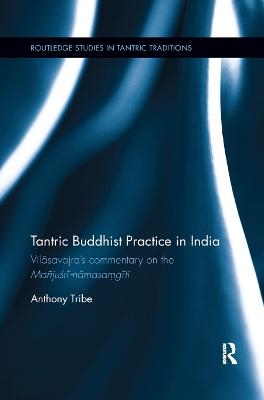
Tantric Buddhist Practice in India
Routledge (Verlag)
978-0-367-87707-1 (ISBN)
The commentary interprets its root text within an elaborate framework of tantric visualisation and meditation that is based on an expanded form of the Buddhist Yoga Tantra mandala, the Vajradhātu-maṇḍala. At its heart is the figure of Mañjuśrī, no longer the familiar bodhisattva of wisdom, but now the embodiment of the awakened non-dual gnosis that underlies all Buddhas as well their activity in the cosmos.
The book contributes to our understanding of the history of Indian tantric Buddhism in a period of significant change and innovation. With its extensively annotated translation and lengthy introductions the book is designed to appeal not only to professional scholars and research students but also to contemporary Buddhists.
Anthony Tribe is an independent scholar with a research specialization in the history and development of tantric Buddhism in India. He is the co-author of Buddhist Thought: A Complete Introduction to the Indian Tradition (2012), also published by Routledge.
Part 1: Introductions
Overview
1. Contexts
2. Vilâsavajra: locating the NMAA’s author
3. The Nâmasaṃgîti
4. Vilâsavajra’s NMAA: overviews and remarks
5. The NMAA’s maṇḍala in Himalayan Art
Part 2: Vilâsavajra’s Nâmamantrârthâvalokinî:
an annotated translation of chapters 1–5
Conventions in the translation
Chapter 1: On ‘The Request for Instruction’
Chapter 2: On ‘The Reply’
Chapter 3: On ‘The Survey of the Six Families’
Chapter 4: On ‘The Method of Awakening According to the Mâyâjâla’
Chapter 5: On ‘The Vajradhâtu-Mahâmaṇḍala of Bodhicittavajra’ Part III: Sanskrit Edition
Materials and Methods
1. Sigla
2. Manuscripts
3. Method of Editing
4. Stemma Codicum
5. The Tibetan Translation of the NMAA
Critical Edition of Vilâsavajra’s Nâmamantrârthâvalokinî:
Chapters 1–5
Adhikâra 1
Adhikâra 2
Adhikâra 3
Adhikâra 4
Adhikâra 5
Textual notes
Insignificant variants
Textual collation to establish the stemma codicum Appendices
Appendix 1. Works and authors cited in the NMAA
Appendix 2. Saṃvara, Cakrasaṃvara and Ṣaṭprajñânaya-
saṃvara citations
Appendix 3. NMAA colophons
Appendix 4. NMAA manuscripts:
| Erscheinungsdatum | 16.12.2019 |
|---|---|
| Reihe/Serie | Routledge Studies in Tantric Traditions |
| Verlagsort | London |
| Sprache | englisch |
| Maße | 156 x 234 mm |
| Gewicht | 453 g |
| Themenwelt | Geisteswissenschaften ► Religion / Theologie ► Buddhismus |
| ISBN-10 | 0-367-87707-4 / 0367877074 |
| ISBN-13 | 978-0-367-87707-1 / 9780367877071 |
| Zustand | Neuware |
| Haben Sie eine Frage zum Produkt? |
aus dem Bereich


